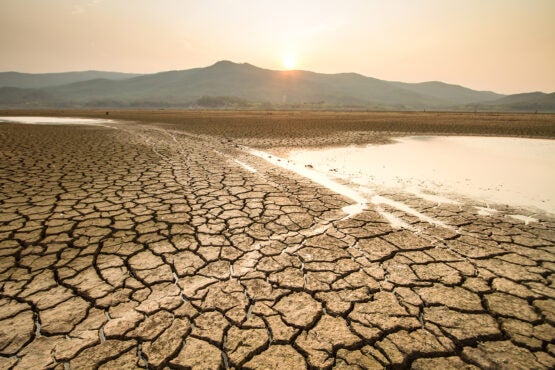n>
New Stanford research shows droughts can make water unaffordable for low-income households
According to a recent study, when providers act to curtail water use or invest in new infrastructure because of a drought, bills can rise for low-income households and drop for high-income households.
By Laura Castañón
Access to safe, affordable water is a necessity for human health and well-being. But when droughts strike areas that are already water-stressed, water providers are forced to enact measures to curtail water usage or invest in supplies from more expensive sources, which can increase costs for consumers. According to a recent study from the Fletcher Lab at Stanford University, published in Nature Water, these measures can disproportionately affect water bills for low-income households, making water more costly for the most vulnerable people.

Researchers examined how different types of drought, various resilience strategies, and household behavior can affect the affordability of water. (Image credit: Shutterstock/Piyaset)
“A low-income household often has a different response to curtailment measures and surcharges because of how much water they used before the drought,” said Benjamin Rachunok, who conducted the work as a postdoctoral researcher at Stanford and is now an assistant professor at North Carolina State University. “This can lead to different affordability outcomes for low- and high-income people, even if the same processes and policies are being applied to everyone.”
The researchers found that in some cases, low-income households end up seeing bills rise during droughts, while high-income households see their bills drop. Their work illuminates the interconnected mechanisms that affect affordability and may be able to help water planners and policymakers better understand the potential impacts of long- and short-term drought responses.
Modeling drought response
Drawing on public data from the 2011 to 2017 drought in California, the researchers built a model to examine how different combinations of drought length and severity, various resilience strategies, and household behavior can affect the affordability of water.
“The standard way of thinking about the connection between water scarcity and affordability has been to look at the cost of supplying water and how that cost is passed on to users through rate design,” said Sarah Fletcher, senior author of the paper and an assistant professor of civil and environmental engineering in Stanford Engineering and the Stanford Doerr School of Sustainability. “But in order to fully understand the impacts of drought on water affordability, we have to include people’s behavioral responses to how the drought is unfolding and the restrictions that are put in place.”
When there is a water shortage, providers often ask consumers to cut back on their water usage, while applying a drought surcharge to bills to make up for lost revenue. Fletcher and Rachunok found that high-income households can cut back significantly, lowering their average water bill even with the addition of a surcharge. Lower-income households, however, tend to have less flexibility in their water usage. Even when they are able to curtail their water use, the drop does not make up for the additional cost of the surcharge.
Water utilities may also invest in infrastructure, such as desalination or water-recycling plants, to increase their water supply. The model showed that in all drought scenarios, these projects increase costs and reduce affordability for low-income households.
“Affordability is a key part of water access,” Fletcher said. “If we think about water security as including affordability for low-income populations, then some of the expensive technological measures that we often consider might actually harm water security by making water unaffordable for a larger number of people.”
An affordable future
Water is typically considered affordable when it does not exceed between 2% and 4% of a household’s income. While the cost of supplying water is the primary driver of water bills, even a small bill increase during droughts could make it difficult for some households to afford the water they need.
By providing insight into the mechanisms that affect affordability, Fletcher and Rachunok hope to help cities evaluate different approaches for long-term water supply planning. They are continuing to investigate how rate structures and other drought management techniques affect people’s behavior and are working to develop a generalized approach to help regulators make the best decisions for an uncertain future.
“We have a changing climate and changing water needs,” Fletcher said. “We have to develop approaches that allow us to adapt in robust ways so that we can still have water systems that are reliable, cost effective, and provide all the services that we need. And we should really be centering the needs of vulnerable communities as we do that adaptation.”
Fletcher is the Lee and Kitty Price center fellow at the Stanford Woods Institute for the Environment.
This work was funded by the Stanford Impact Labs and the UPS Endowment Fund at Stanford University.
To read all stories about Stanford science, subscribe to the biweekly Stanford Science Digest.
-30-
 |